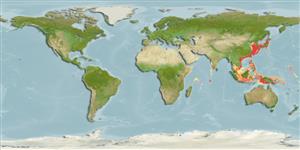分类 / Names
俗名 | 同种异名 | Catalog of Fishes(属, 种) | ITIS | CoL | WoRMS | Cloffa
Elasmobranchii
板鳃亚纲 (鲨鱼与 鱼) (sharks and rays) >
Carcharhiniformes (Ground sharks)
白眼鮫目 (Ground sharks) >
Triakidae (Houndsharks)
平滑鮫科 (Houndsharks) > Triakinae
Etymology: Mustelus: Latin for weasel, an ancient name for sharks, possibly referring to the pointed snouts, swift movements and/or rapacious feeding behavior of smaller predatory sharks [strictly not tautonymous with Squalus mustelus Linnaeus 1758 since type was designated by the ICZN] (See ETYFish); manazo: Japanese vernacular for this shark (See ETYFish).
More on author: Bleeker.
Environment: milieu / climate zone / depth range / distribution range
生态学
海洋 居于水底的; 深度上下限 0 - 360 m (Ref. 13563). 深水域; 45°N - 10°S
Western Indian Ocean: Kenya. Western Pacific: southern Siberia, Japan, Korea, China, Taiwan and Viet Nam; Chesterfield Islands (Ref. 11897).
西印度洋: 肯亞。 西太平洋: 西伯利亞南部,日本,韓國,中國,台灣與越南; 赤斯特菲群島.(參考文獻 11897)
Length at first maturity / 大小 / 重量 / 年龄
Maturity: Lm 65.0, range 62 - 68 cm
Max length : 220 cm TL 雄鱼/尚未辨别雌雄; (Ref. 4883); 最大体重: 5.7 kg (Ref. 40637); 最大年龄: 10 年 (Ref. 6081)
Found in the intertidal zone, on mud and sand bottom, down to a depth of at least 360 m (Ref. 13563). May also be found in semi-enclosed sea areas (Ref. 11230). Feeds mainly on bottom invertebrates, also bony fishes (Ref. 244). Ovoviviparous (Ref. 50449). Caught regularly by demersal longliners operating both inshore and in deep-water (Ref.58048). Utilized for human consumption (Ref. 244).
发现于了泥地与沙地底部之上的潮间带向下至深度至少 360 公尺。 (参考文献 13563) 可能也被发现于半封闭的海洋区域.(参考文献 11230) 主要吃底栖无脊椎动物,也捕食硬骨鱼类。 (参考文献 244) 卵胎生的.(参考文献 50449) 供人类食用.(参考文献 244)
Life cycle and mating behavior
成熟度 | 繁殖 | 产卵场 | 卵 | 孕卵数 | 仔鱼
Ovoviviparous, embryos feed solely on yolk (Ref. 50449), with 1 to 22 (Ref.58048 reports 5-14)young in a litter. Gestation period takes about 10 months (Ref. 244) or 11-12 months (Ref. 28055). Young born in spring. Distinct pairing with embrace (Ref. 205).西印度洋: 肯亞。 西太平洋: 西伯利亞南部,日本,韓國,中國,台灣與越南; 赤斯特菲群島.(參考文獻 11897)
Compagno, L.J.V., 1984. FAO Species Catalogue. Vol. 4. Sharks of the world. An annotated and illustrated catalogue of shark species known to date. Part 2 - Carcharhiniformes. FAO Fish. Synop. 125(4/2):251-655. Rome: FAO. (Ref. 244)
世界自然保护联盟红皮书 (Ref. 130435: Version 2024-2)
濒危 (EN) (A2d); Date assessed: 06 May 2020
人类利用
渔业: 商业性; 游钓鱼种: 是的
工具
特别资料
下载 XML
网络资源
Estimates based on models
Preferred temperature (Ref.
123201): 14.4 - 28.1, mean 23.2 °C (based on 677 cells).
Phylogenetic diversity index (Ref.
82804): PD
50 = 0.5000 [Uniqueness, from 0.5 = low to 2.0 = high].
Bayesian length-weight: a=0.00214 (0.00116 - 0.00393), b=3.12 (2.96 - 3.28), in cm total length, based on LWR estimates for this species & Genus-body shape (Ref.
93245).
营养阶层 (Ref.
69278): 3.7 ±0.1 se; based on diet studies.
回复力 (Ref.
120179): 非常低的, 最小族群倍增时间超过14 年 (K=0.07; tm=1.9-4; tmax=10; Fec=1).
Fishing Vulnerability (Ref.
59153): High vulnerability (63 of 100).
Nutrients (Ref.
124155): Calcium = 17.6 [5.5, 90.4] mg/100g; Iron = 0.424 [0.128, 1.518] mg/100g; Protein = 21.1 [18.7, 23.4] %; Omega3 = 0.0841 [, ] g/100g; Selenium = 116 [33, 429] μg/100g; VitaminA = 7.92 [2.91, 21.89] μg/100g; Zinc = 0.767 [0.337, 1.566] mg/100g (wet weight);
